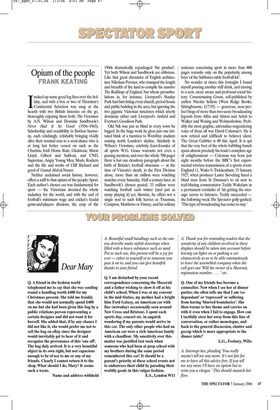Opium of the people
FRANK KEATING
Istoked up some good log fires over the holiday, and with a box or two of Thornton’s Continental Selection was snug at the hearth with two British histories on the go, thoroughly enjoying them both: The Victorians by A.N. Wilson and Dominic Sandbrook’s Never Had It So Good (1956–1963). Scholarship and readability in flawless harmony, each relishingly, relishably bringing vividly alive their seminal eras to a semi-dunce who is at long last better versed on such as the Chartists, Irish Home Rule, Gladstone, Marie Lloyd, Gilbert and Sullivan, and CND, Supermac, Angry Young Men, Mods, Rockers and the life and works of Cliff Richard and good ol’ Gamal Abd al-Nasser.
Neither acclaimed social history, however, offers a sniff to that opium of the people: Sport. Each author’s chosen era was fundamental for sport — the Victorians invented the whole malarkey for the world, and with the end of football’s minimum wage and cricket’s feudal gents-and-players divisions, the cusp of the 1960s dramatically repackaged ‘the product’. Yet both Wilson and Sandbrook are oblivious. Like that great chronicler of English architecture Nikolaus Pevsner, who tramped the length and breadth of the land to compile his massive The Buildings of England, but whose perambulations in, for instance, Liverpool’s Stanley Park had him listing every church, period house and public building in the area, but ignoring the two gigantic Victorian structures which utterly dominate either end: Liverpool’s Anfield and Everton’s Goodison Park.
Old Nik was just as blind in every town he logged. In the huge work he gives just one irritated blink of a mention to Wembley stadium ruining north London’s skyline. Similarly in Wilson’s Victorians, celebrity feast-founder of all sports W.G. Grace warrants not even a passing mention, and over the whole 700-pager there is but one desultory paragraph about the birth of Britain’s football obsession — at the time of Victoria’s death, in the First Division alone, more than six million were watching matches every Saturday. Half a century later, in Sandbrook’s chosen period, 33 million were watching football each winter (and just as many playing it) yet, likewise, he offers not a single nod to such folk heroes as Trueman, Compton, Matthews or Finney, and his solitary sentence concerning sport in more than 800 pages remarks only on the popularity among boys ‘of the Subbuteo table football kit’.
No wonder at times this fortnight I found myself pouring another stiff drink, and turning to a new, more aware and profound social history: Commentating Greats, self-published by author Nicolas Sellens (West Ridge Books, Sittingbourne, £17.95) — generous, near-perfect biogs of more than two-score broadcasting legends from Alliss and Alston and Arlott to Walker and Waring and Wolstenholme. Probably the most graphic, adrenaline-engendering voice of them all was David Coleman’s. He is now retired and (difficult to believe) silent. The Great Gabbler is 80 this April. It is apt that the very best of the whole babbling bunch spans almost precisely his trade’s complete age of enlightenment — Coleman was born just eight months before the BBC’s first experimental wireless transmission of a sports event: England 11, Wales 9, Twickenham, 15 January 1927, when producer Lance Sieveking hired a blind man from St Dunstan’s to sit next to trail-blazing commentator Teddy Wakelam as a permanent reminder of his getting the message across to listeners. Teddy succeeded the following week The Spectator golly-gushed: ‘This type of broadcasting has come to stay.’





































 Previous page
Previous page